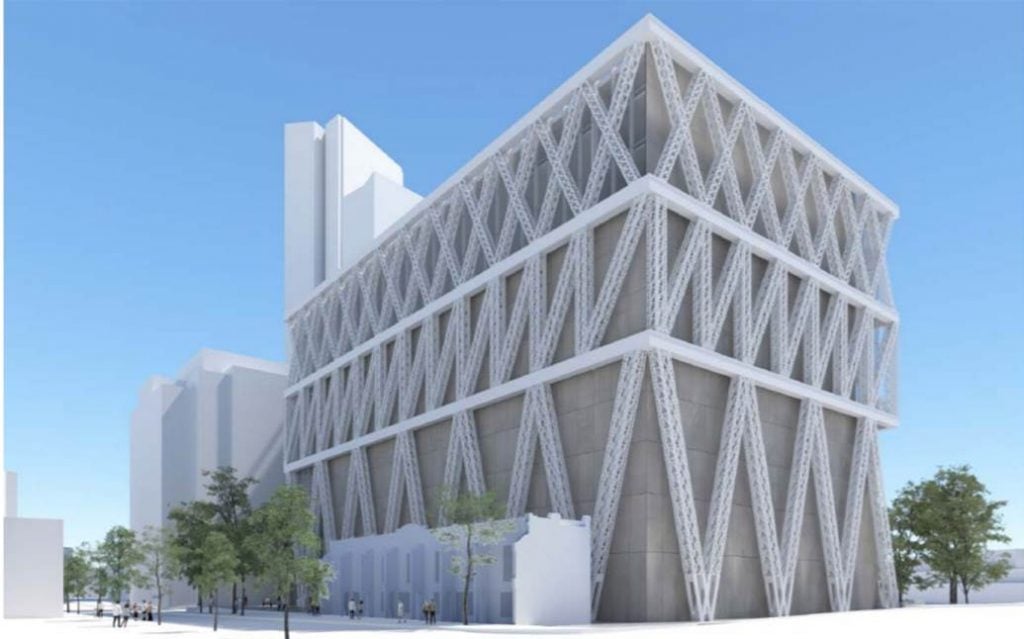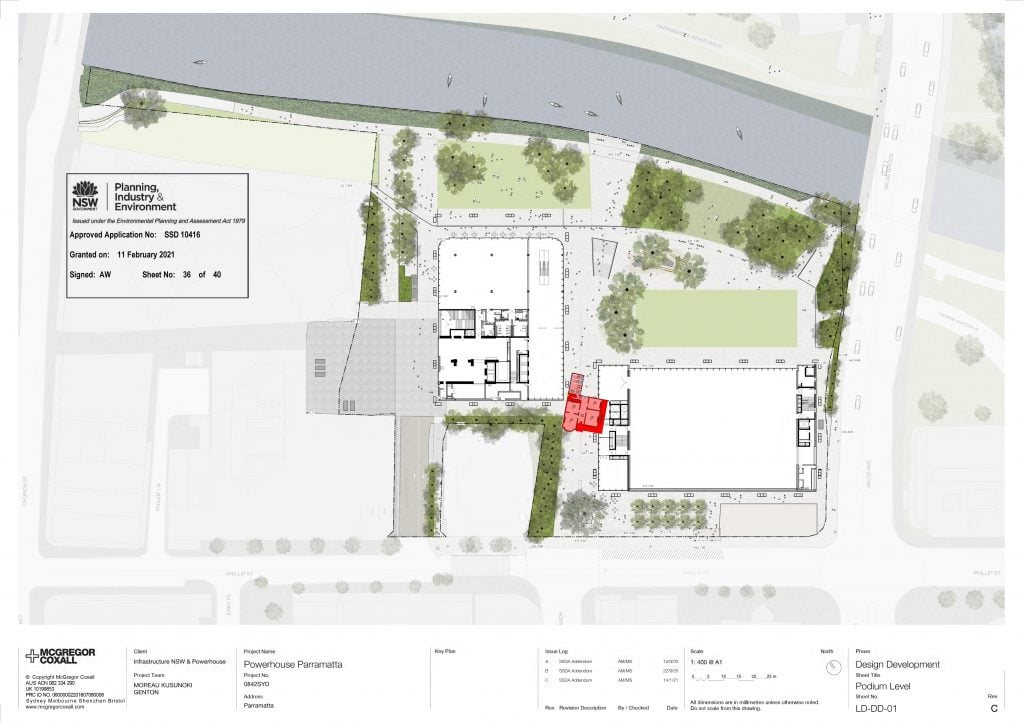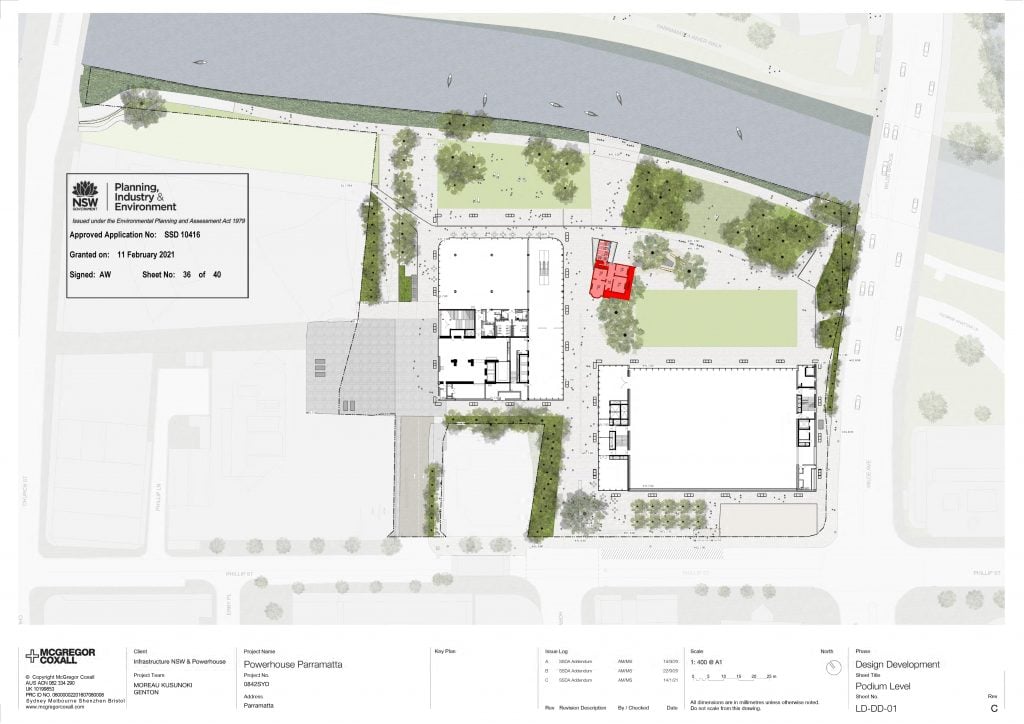Increasingly, people are beginning to recognise that heritage is not just about a “thing”, it is also about “place”. The battle over Parramatta’s historic “Willow Grove”, a grand house in a riverside location, exemplifies this issue.
A new Museum was proposed on a very large site along the Parramatta River, occupied by two historic buildings, Willow Grove (c.1886) and St Georges Terrace (1881). There was the ability for these buildings to be retained as part of a museum design that responded specifically to its location, but this was not conditioned. The proposed museum simply cleared the site of these troublesome structures, and the result tells us much about our current perceived attitudes to heritage. The protests over the planned demolition of these buildings has yielded two equally sad results.
St Georges Terrace
The partial retention of St George’s Terrace represents the very worst of contemporary attitudes and responses to heritage. In a “Revised Design” the proposed Powerhouse building was moved slightly, its exoskeleton frame now simply abutting the truncated rear of this little row of old buildings.
Unlike other celebrated new building designs that respond to their site conditions and existing streetscape patterns, the Powerhouse design was not changed at all to respond to the terraces, resulting in a poor architectural design result for both the old and the new. Devoid of meaning, the remaining terraces will look simply like a postage stamp stuck on the corner of this new building – clearly a historical imposition rather than a celebration of Parramatta’s heritage, or indeed a considered component of new museum such as occurred at the Museum of Sydney site.
The National Trust scrutinised the formal Heritage Impact Assessment for St Georges Terrace – a document that was required to assess the impact of the new Powerhouse on the historic terraces. The critical question that needed to be asked was clearly stated on page 21 of the report: “Will the additions visually dominate the heritage item?” The answer the report gave that was accepted by the Department? “Not applicable.”
We will let you be the judge.

Willow Grove
In an equally extraordinary decision, it was also announced that Willow Grove was to be “protected” and “saved for future generations.” This was not the result of the new Powerhouse building being designed to accommodate the retention of this historic Parramatta riverside home, but rather by “dismantling” it and moving it somewhere presumably more convenient.
If the retention of St Georges Terrace was a bad heritage outcome, then the relocation of Willow Grove was worse. The National Trust maintained from the outset that Willow Grove should remain in its original position, and be sensitively repaired. It could form part of a new museum. It only requires a simple review of the site plan to show how easily this could have been achieved.

It has been put forward that other historic buildings have been successfully been moved in the past and this is an acceptable heritage outcome. The National Trust do not consider this is ever a good heritage outcome, because setting is an important part of a building’s significance. We do however note that in some cases buildings have been literally moved (not dismantled) small distances in a way that at least does not involve their total demolition and retains at least some connection to their original setting. In NSW, the historic Hornsby Signal Box was moved 150m in 2007 to facilitate a new railway line. A similar method could be employed here, and the Trust did attempt, as a last-ditch-effort, to present such a proposal to the NSW Government but our advances were declined.
Such a proposal would involve physically moving Willow Grove a mere 50m to form part of the new museum’s riverside park. This way, Willow Grove could retain some of its significance by the river, potentially form part of the new museum, and be a fitting end point to the Parramatta Civic Link (a role it was originally intended to fulfil when the link was first proposed). It would also retain most of its original fabric. As far as we are aware, this less destructive alternative has never been considered.

The National Trust continue to hold grave concerns for the proposed “relocation” of Willow Grove. The Relocation Framework and Methodology Plan (RFMP), in the opinion of the National Trust, does not meet the requirements for such a document as outlined in the Conditions of Consent for this project. This document contains no architectural or measured drawings; no annotated photographs; no clear scope, schedules or methodology.
Dismantling a building of this size and age is a complex task, however the methodology for deconstruction and relocation in the RFMP is covered in two pages, while the description of the equally complex task of relocating and reconstructing Willow Grove is not even one page in length. The Trust raised these issues the Department of Planning, Industry and Environment and have been informed that the document “complies with the requirements of Condition B2 of the consent and it provides a suitable framework for the deconstruction and storage of the heritage fabric.”
The relocation of Willow Grove has been presented as a good heritage outcome. It is not.
The National Trust maintain:
- This is demolition, not “dismantling”. Willow Grove is not a sandstone church that can be taken apart stone by stone. It is a fragile, cement rendered house, made of old bricks, with lath-and-plaster ceilings and plastered internal walls. Any attempt to dismantle these materials will easily result in their catastrophic failure.
- The only parts that can reasonably be expected to be removed are the old doors, windows, and iron verandah, and maybe the odd bit of internal timber joinery like a staircase. No sensible builder will re-use the old roof slates, wiring or plumbing connections, and floor joists will all likely be replaced too.
- This means that any “re-erected” building will of necessity comprise mostly of new materials. It will have all new walls, roofs and floors, with perhaps some old verandahs and doors attached. Make no mistake, we will be left with a fake old building.
- Moving Willow Grove from its present site will reduce its cultural and historic significance, and it will negatively impact the significance of any new location in historic North Parramatta. An inappropriate new site for this fake building would in fact be a worse heritage outcome than straightforward demolition.
- The costs associated with “rebuilding” are considerable, and will bring little to no benefit to the heritage and people of Parramatta. The amount of money being diverted from other worthwhile heritage projects around NSW to achieve this pathetic outcome is deeply saddening.
The demolition of greater Sydney’s historic buildings is not something consigned to the 1960s – it is happening now, despite all of our heritage lists and laws.
When the demolishers move in and Willow Grove disappears, it will be yet another piece of the “Cradle City” of Parramatta gone forever. Piece-by-piece, it is disappearing until we have almost nothing left – and what is left, often standing lost, isolated, undignified and forlorn.
How sad that another piece of that history has disappeared, and to make way, of all things, for a museum.

 Twitter
Twitter Facebook
Facebook Linkedin
Linkedin Email
Email
Dear David
An excellent summary of a very bleak period in the history of heritage conservation in NSW. Two bad outcomes for heritage and Parramatta and a former premier’s thought bubble turned into a museum that is neither well located nor fit for purpose. I have lost my birthplace with the demolition of ‘Willow Grove’. As someone passionate about Parramatta’s heritage, I have witnessed in my lifetime the loss of so much of that heritage from a city which until the 1960s retained so much of its past from the earliest days of European settlement. The decision to make Parramatta the second CBD of Sydney was a mistake, but once made, could have been planned so much better, with the colonial core of the city retained and new development located closer to the rail junction at Granville – similar to the separation of the Paris so many love and the high rise of La Défense. The historic buildings that remain in Parramatta have mostly had their settings compromised by new development and this continues at a frightening pace. We deserve much, much better.
With sympathy for Parramatta’s loss
Chris Betteridge BSc MSc (Museum Studies), AMA, M.ICOMOS, M.IA
Heritage practitioner
Hello Chris,
Thank you for your comment, and amazing to consider you and so many others were born in Willow Grove. Parramatta was (and in some parts, remains) a place with great opportunity for thoughtful redevelopment that engages with its unique history. Too often however, we are seeing those opportunities missed, with very sad results. It need not be that way.
David